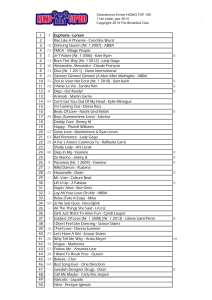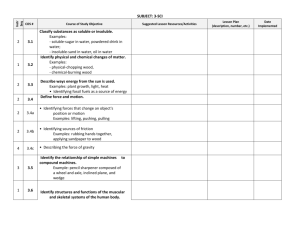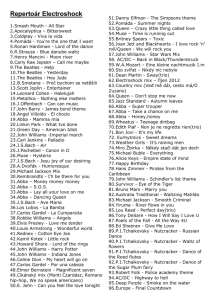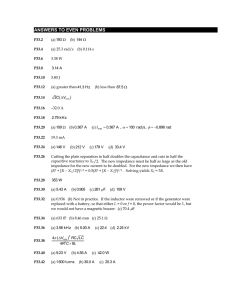PowerPoint
advertisement
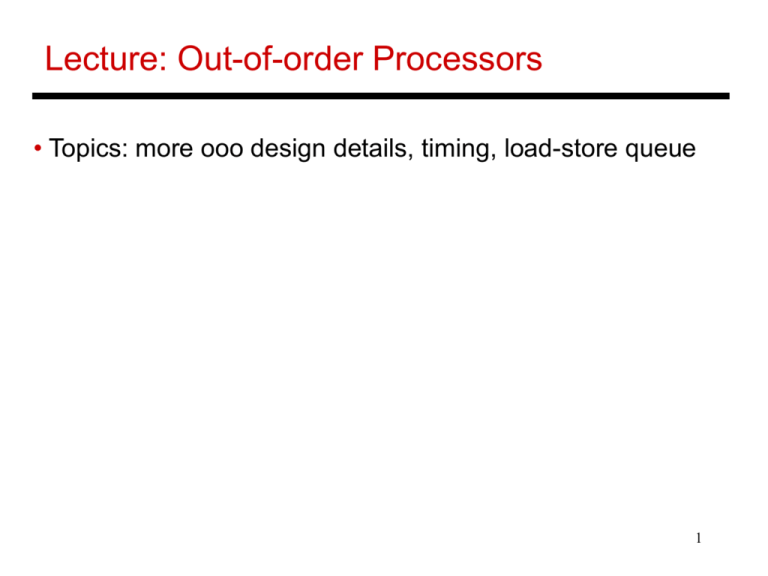
Lecture: Out-of-order Processors • Topics: more ooo design details, timing, load-store queue 1 Problem 1 • Show the renamed version of the following code: Assume that you have 36 physical registers and 32 architected registers. When does each instr leave the IQ? R1 R2+R3 R1 R1+R5 BEQZ R1 R1 R4 + R5 R4 R1 + R7 R1 R6 + R8 R4 R3 + R1 R1 R5 + R9 2 Problem 0 • Show the renamed version of the following code: Assume that you have 36 physical registers and 32 architected registers. When does each instr leave the IQ? R1 R2+R3 P33 P2+P3 cycle i R1 R1+R5 P34 P33+P5 i+1 BEQZ R1 BEQZ P34 i+2 R1 R4 + R5 P35 P4+P5 i R4 R1 + R7 P36 P35+P7 i+1 R1 R6 + R8 P1 P6+P8 j R4 R3 + R1 P33 P3+P1 j+1 R1 R5 + R9 P34 P5+P9 j+2 Width is assumed to be 4. j depends on the #stages between issue and commit. 3 OOO Example IQ • Assume there are 36 physical registers and 32 logical registers, and width is 4 • Estimate the issue time, completion time, and commit time for the sample code 4 Assumptions IQ • Perfect branch prediction, instruction fetch, caches • ADD dep has no stall; LD dep has one stall • An instr is placed in the IQ at the end of its 5th stage, an instr takes 5 more stages after leaving the IQ (ld/st instrs take 6 more stages after leaving the IQ) 5 OOO Example IQ Original code ADD R1, R2, R3 LD R2, 8(R1) ADD R2, R2, 8 ST R1, (R3) SUB R1, R1, R5 LD R1, 8(R2) ADD R1, R1, R2 Renamed code 6 OOO Example IQ Original code ADD R1, R2, R3 LD R2, 8(R1) ADD R2, R2, 8 ST R1, (R3) SUB R1, R1, R5 LD R1, 8(R2) ADD R1, R1, R2 Renamed code ADD P33, P2, P3 LD P34, 8(P33) ADD P35, P34, 8 ST P33, (P3) SUB P36, P33, P5 Must wait 7 OOO Example IQ Original code ADD R1, R2, R3 LD R2, 8(R1) ADD R2, R2, 8 ST R1, (R3) SUB R1, R1, R5 LD R1, 8(R2) ADD R1, R1, R2 Renamed code ADD P33, P2, P3 LD P34, 8(P33) ADD P35, P34, 8 ST P33, (P3) SUB P36, P33, P5 InQ Iss Comp Comm 8 OOO Example IQ Original code ADD R1, R2, R3 LD R2, 8(R1) ADD R2, R2, 8 ST R1, (R3) SUB R1, R1, R5 LD R1, 8(R2) ADD R1, R1, R2 Renamed code ADD P33, P2, P3 LD P34, 8(P33) ADD P35, P34, 8 ST P33, (P3) SUB P36, P33, P5 InQ i i i i i+1 Iss i+1 i+2 i+4 i+2 i+2 Comp Comm i+6 i+6 i+8 i+8 i+9 i+9 i+8 i+9 i+7 i+9 9 OOO Example IQ Original code ADD R1, R2, R3 LD R2, 8(R1) ADD R2, R2, 8 ST R1, (R3) SUB R1, R1, R5 LD R1, 8(R2) ADD R1, R1, R2 Renamed code ADD P33, P2, P3 LD P34, 8(P33) ADD P35, P34, 8 ST P33, (P3) SUB P36, P33, P5 LD P1, 8(P35) ADD P2, P1, P35 InQ i i i i i+1 i+7 i+9 Iss Comp Comm i+1 i+6 i+6 i+2 i+8 i+8 i+4 i+9 i+9 i+2 i+8 i+9 i+2 i+7 i+9 i+8 i+14 i+14 i+10 i+15 i+15 10 The Alpha 21264 Out-of-Order Implementation Reorder Buffer (ROB) Instr 1 Instr 2 Instr 3 Instr 4 Instr 5 Instr 6 Branch prediction and instr fetch R1 R1+R2 R2 R1+R3 BEQZ R2 R3 R1+R2 R1 R3+R2 Instr Fetch Queue Committed Reg Map R1P1 R2P2 Register File P1-P64 Decode & Rename Speculative Reg Map R1P36 R2P34 P33 P1+P2 P34 P33+P3 BEQZ P34 P35 P33+P34 P36 P35+P34 Issue Queue (IQ) ALU ALU ALU Results written to regfile and tags broadcast to IQ 11 Additional Details • When does the decode stage stall? When we either run out of registers, or ROB entries, or issue queue entries • Issue width: the number of instructions handled by each stage in a cycle. High issue width high peak ILP • Window size: the number of in-flight instructions in the pipeline. Large window size high ILP • No more WAR and WAW hazards because of rename registers – must only worry about RAW hazards 12 Branch Mispredict Recovery • On a branch mispredict, must roll back the processor state: throw away IFQ contents, ROB/IQ contents after branch • Committed map table is correct and need not be fixed • The speculative map table needs to go back to an earlier state • To facilitate this spec-map-table rollback, it is checkpointed at every branch 13 Waking Up a Dependent • In an in-order pipeline, an instruction leaves the decode stage when it is known that the inputs can be correctly received, not when the inputs are computed • Similarly, an instruction leaves the issue queue before its inputs are known, i.e., wakeup is speculative based on the expected latency of the producer instruction 14 Out-of-Order Loads/Stores Ld R1 [R2] Ld R3 [R4] St R5 [R6] Ld R7 [R8] Ld R9[R10] What if the issue queue also had load/store instructions? Can we continue executing instructions out-of-order? 15 Memory Dependence Checking Ld 0x abcdef Ld St Ld Ld 0x abcdef St 0x abcd00 Ld 0x abc000 Ld 0x abcd00 • The issue queue checks for register dependences and executes instructions as soon as registers are ready • Loads/stores access memory as well – must check for RAW, WAW, and WAR hazards for memory as well • Hence, first check for register dependences to compute effective addresses; then check for memory dependences 16 Memory Dependence Checking Ld 0x abcdef Ld St Ld Ld 0x abcdef St 0x abcd00 Ld 0x abc000 Ld 0x abcd00 • Load and store addresses are maintained in program order in the Load/Store Queue (LSQ) • Loads can issue if they are guaranteed to not have true dependences with earlier stores • Stores can issue only if we are ready to modify memory (can not recover if an earlier instr raises an exception) – happens at commit 17 The Alpha 21264 Out-of-Order Implementation Reorder Buffer (ROB) Instr 1 Committed Instr 2 Reg Map Instr 3 R1P1 Instr 4 R2P2 Instr 5 Instr 6 Instr 7 Branch prediction and instr fetch R1 R1+R2 R2 R1+R3 BEQZ R2 R3 R1+R2 R1 R3+R2 LD R4 8[R3] ST R4 8[R1] Instr Fetch Queue Decode & Rename Speculative Reg Map R1P36 R2P34 P33 P1+P2 P34 P33+P3 BEQZ P34 P35 P33+P34 P36 P35+P34 P37 8[P35] P37 8[P36] Issue Queue (IQ) P37 [P35 + 8] P37 [P36 + 8] LSQ Register File P1-P64 ALU ALU ALU Results written to regfile and tags broadcast to IQ ALU D-Cache 18 Problem 2 • Consider the following LSQ and when operands are available. Estimate when the address calculation and memory accesses happen for each ld/st. Assume no memory dependence prediction. Ad. Op St. Op Ad.Val Ad.Cal Mem.Acc LD R1 [R2] 3 abcd LD R3 [R4] 6 adde ST R5 [R6] 4 7 abba LD R7 [R8] 2 abce ST R9 [R10] 8 3 abba LD R11 [R12] 1 abba 19 Problem 2 • Consider the following LSQ and when operands are available. Estimate when the address calculation and memory accesses happen for each ld/st. Assume no memory dependence prediction. Ad. Op St. Op Ad.Val Ad.Cal Mem.Acc LD R1 [R2] 3 abcd 4 5 LD R3 [R4] 6 adde 7 8 ST R5 [R6] 4 7 abba 5 commit LD R7 [R8] 2 abce 3 6 ST R9 [R10] 8 3 abba 9 commit LD R11 [R12] 1 abba 2 10 20 Problem 3 • Consider the following LSQ and when operands are available. Estimate when the address calculation and memory accesses happen for each ld/st. Assume no memory dependence prediction. Ad. Op St. Op Ad.Val Ad.Cal Mem.Acc LD R1 [R2] 3 abcd LD R3 [R4] 6 adde ST R5 [R6] 5 7 abba LD R7 [R8] 2 abce ST R9 [R10] 1 4 abba LD R11 [R12] 2 abba 21 Problem 3 • Consider the following LSQ and when operands are available. Estimate when the address calculation and memory accesses happen for each ld/st. Assume no memory dependence prediction. Ad. Op St. Op Ad.Val Ad.Cal Mem.Acc LD R1 [R2] 3 abcd 4 5 LD R3 [R4] 6 adde 7 8 ST R5 [R6] 5 7 abba 6 commit LD R7 [R8] 2 abce 3 7 ST R9 [R10] 1 4 abba 2 commit LD R11 [R12] 2 abba 3 5 22 Problem 4 • Consider the following LSQ and when operands are available. Estimate when the address calculation and memory accesses happen for each ld/st. Assume memory dependence prediction. Ad. Op St. Op Ad.Val Ad.Cal Mem.Acc LD R1 [R2] 3 abcd LD R3 [R4] 6 adde ST R5 [R6] 4 7 abba LD R7 [R8] 2 abce ST R9 [R10] 8 3 abba LD R11 [R12] 1 abba 23 Problem 4 • Consider the following LSQ and when operands are available. Estimate when the address calculation and memory accesses happen for each ld/st. Assume memory dependence prediction. Ad. Op St. Op Ad.Val Ad.Cal Mem.Acc LD R1 [R2] 3 abcd 4 5 LD R3 [R4] 6 adde 7 8 ST R5 [R6] 4 7 abba 5 commit LD R7 [R8] 2 abce 3 4 ST R9 [R10] 8 3 abba 9 commit LD R11 [R12] 1 abba 2 3/10 24 Title • Bullet 25
